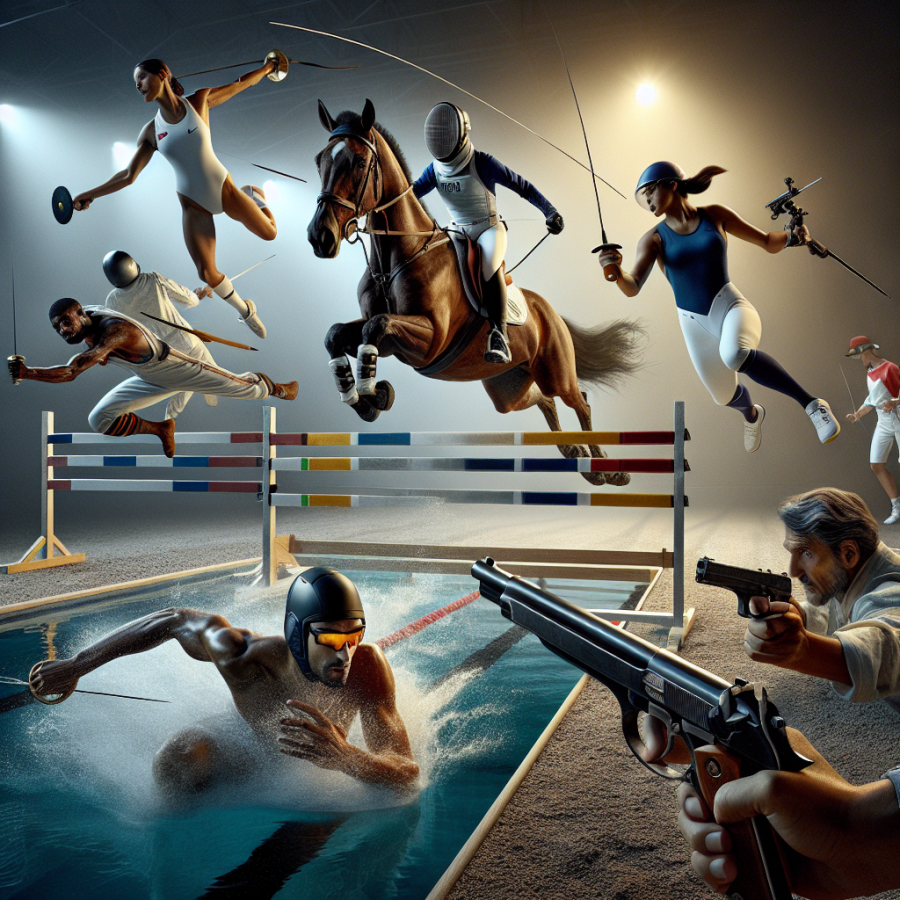Mastering the Multifaceted Challenge: A Look into Pentathlon's Diverse Events
Pentathlon, an Olympic sport that showcases the versatility and endurance of its athletes, is composed of five distinct disciplines—fencing, swimming, equestrian show jumping, and a combined event of pistol shooting and cross-country running. Each event in the modern pentathlon represents a different aspect of physical and mental skill, requiring competitors to not only specialize in multiple areas but also to quickly shift gears and strategies as they move from one challenge to the next.
The sport begins with fencing, a test of reflexes, strategy, and precise technique. Each athlete must face every other competitor in a series of one-touch épée bouts, a process that demands as much psychological fortitude as it does physical skill. The rapid-fire nature of these confrontations sets an intense pace for the day, requiring athletes to make split-second decisions and adjustments.
Following fencing, athletes dive into the pool for a 200-meter freestyle swim. Swimming demands a different type of physical prowess, combining aerobic endurance with the technique to slice through the water with efficiency. Athletes must have conditioned their bodies to recover swiftly from the intensity of fencing, recalibrating their heart rates and engaging different muscle groups for optimal performance in the water.
The equestrian show jumping phase introduces an entirely different dynamic to the pentathlon, as athletes must now showcase their horsemanship. Competitors have only a brief period to bond with an unfamiliar horse before navigating a course with a series of jumps. Success in this event requires adaptability, calm under pressure, and a trusting relationship between horse and rider, despite the limited preparation time. Each jump and each stride taken is a gamble, and only those with an innate understanding of their mount can hope to clear the course without faults.
Finally, the climax of the pentathlon is the laser-run, a combination of pistol shooting and cross-country running. Athletes must alternate between running laps and shooting at targets, with the added challenge of managing their heart rates and composure to hit five targets within a 50-second time limit before heading back on the track. This event is the ultimate test of focus, endurance, and precision under fatigue. Breathing control and the ability to remain collected while transitioning from high cardiovascular exertion to the fine motor skills required for shooting are essential for excelling in this final event.
Mastering these varied events requires a unique blend of multifaceted training regimes, mental resilience, and tactical intelligence.
Read also:
Navigating the Excitement: A Detailed Look at When Soccer Season Begins
Training for Triumph: How Pentathletes Prepare for Ultimate Versatility
Pentathletes stand as paragons of versatility, embodying a unique blend of skills that spans five distinct disciplines. Each event in the modern pentathlon—fencing, swimming, show jumping, pistol shooting, and cross-country running—demands a different skill set, and athletes must prepare rigorously to excel in each one. The training regime of a pentathlete is a finely-tuned balance of varied workouts, technical refinement, and mental preparation, all aimed at achieving peak performance across all five events.
Fencing, the opening event, requires precision, agility, and quick decision-making. Pentathletes spend countless hours honing their technique, engaging in drills that sharpen their reflexes and bouts that simulate competition conditions. Footwork drills and tactical exercises are also crucial for gaining an advantage over opponents. Fencing coaches work closely with athletes to develop strategies for the one-touch épée matches, emphasizing the importance of a calm and focused mindset.
The swimming event, typically a 200-meter freestyle race, calls for excellent aquatic capabilities. Training involves rigorous pool sessions designed to enhance stroke efficiency, build endurance, and improve turn and start techniques. Coaches use video analysis to critique stroke mechanics and ensure each swimmer is using energy optimally. Dryland training, including strength and conditioning exercises, optimizes power generation and core stability necessary for a strong swim performance.
Show jumping is arguably the most technically complex event, demanding a harmonious relationship between athlete and horse. Since pentathletes are paired with unfamiliar horses, they must be adept equestrians, capable of quickly establishing rapport and commanding the horse over a series of jumps. Riders spend many hours practicing on different horses to become adaptable to various temperaments and riding styles. This training not only includes jumping but also flatwork to enhance control and communication with the horse.
Shooting, now paired with running in the laser-run event, emphasizes precision under duress. Athletes train to lower their heart rate quickly after running, aiming for accuracy with the laser pistol. Mental fortitude is crucial; thus, visualization and breathing techniques are integrated into training. Repetitive practice of the transition from running to shooting helps pentathletes maintain composure and focus, vital for hitting the five targets in the shortest possible time before returning to the track.
Cross-country running, the final event, tests the pentathlete's endurance and willpower. Training emphasizes building a strong aerobic base through long-distance runs, while also incorporating interval training to boost speed and recovery.




